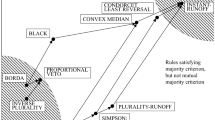Abstract
We introduce a new parameter which we call the nonmanipulative vote-deficit (NMVD) for single-winner voting rules. In particular, the NMVD of a voting rule at an election is the minimum number of votes needed to be added to transform this election into a nonmanipulable one yet without changing the winner. A voting rule has a bounded NMVD if the NMVDs of this rule at all elections are bounded from above by a constant. We show that the prevalent voting rules Borda, Plurality with Runoff, and Maximin have bounded NMVDs. In addition, we show that the NMVD of r-Approval, r-Veto, and Bucklin at every election can be bounded by a function of the number of candidates. For Copeland\(^{\alpha }\), though that in general the NMVDs at elections cannot be bounded by a function of the number of candidates, we show that many special elections are still expected to have small NMVDs. Many of our results are tight.
Access this chapter
Tax calculation will be finalised at checkout
Purchases are for personal use only
Similar content being viewed by others
Notes
- 1.
- 2.
A Condorcet winner is a candidate which beats all the other candidates. A voting rule is Condorcet-consistent if it selects the Condorcet winner as the winner whenever the Condorcet winner exists. Condorcet-consistency is a significant axiomatic property of voting rules (see [22, Figure 9.3] or [21, Table 2] for voting rules and their axiomatic properties).
References
Aziz, H., Gaspers, S., Mattei, N., Narodytska, N., Walsh, T.: Ties matter: complexity of manipulation when tie-breaking with a random vote. In: AAAI, pp. 74–80 (2013)
Bachmeier, G., et al.: \(k\)-majority digraphs and the hardness of voting with a constant number of voters. J. Comput. Syst. Sci. 105, 130–157 (2019)
Bartholdi III, J.J., Orlin, J.B.: Single transferable vote resists strategic voting. Soc. Choice Welfare 8(4), 341–354 (1991). https://doi.org/10.1007/BF00183045
Bartholdi III, J.J., Tovey, C.A., Trick, M.A.: The computational difficulty of manipulating an election. Soc. Choice Welfare 6(3), 227–241 (1989). https://doi.org/10.1007/BF00295861
Bartholdi III, J.J., Tovey, C.A., Trick, M.A.: How hard is it to control an election? Math. Comput. Model. 16(8–9), 27–40 (1992)
Betzler, N., Niedermeier, R., Woeginger, G.J.: Unweighted coalitional manipulation under the Borda rule is NP-hard. In: IJCAI, pp. 55–60 (2011)
Black, D.: On the rationale of group decision-making. J. Polit. Econ. 56(1), 23–34 (1948)
Cary, D.: Estimating the margin of victory for instant-runoff voting. In: EVT/WOTE (2011)
Elkind, E., Grandi, U., Rossi, F., Slinko, A.: Gibbard-Satterthwaite games. In: IJCAI, pp. 533–539 (2015)
Erdős, P., Moser, L.: On the representation of directed graphs as unions of orderings. Math. Inst. Hung. Acad. Sci. 9, 125–132 (1964)
Faliszewski, P., Rothe, J.: Control and bribery in voting. In: Brandt, F., Conitzer, V., Endriss, U., Lang, J., Procaccia, A. (eds.) Handbook of Computational Social Choice, chap. 7, pp. 146–168. Cambridge University Press (2016)
Gibbard, A.: Manipulation of voting schemes: a general result. Econometrica 41(4), 587–601 (1973)
Gibbard, A.: Manipulation of schemes that mix voting with chance. Econometrica 45(3), 665–681 (1977)
Magrino, T.R., Rivest, R.L., Shen, E.: Computing the margin of victory in IRV elections. In: EVT/WOTE (2011)
Mattei, N., Walsh, T.: PrefLib: a library for preferences http://www.preflib.org. In: Perny, P., Pirlot, M., Tsoukiàs, A. (eds.) ADT 2013. LNCS (LNAI), vol. 8176, pp. 259–270. Springer, Heidelberg (2013). https://doi.org/10.1007/978-3-642-41575-3_20
Menton, C., Singh, P.: Manipulation can be hard in tractable voting systems even for constant-sized coalitions. Comput. Sci. Rev. 6(2–3), 71–87 (2012)
Moulin, H.: On strategy-proofness and single peakedness. Public Choice 35(4), 437–455 (1980)
Obraztsova, S., Elkind, E., Hazon, N.: Ties matter: complexity of voting manipulation revisited. In: AAMAS, pp. 71–78 (2011)
Procaccia, A.D.: Can approximation circumvent Gibbard-Satterthwaite? In: AAAI, pp. 836–841 (2010)
Satterthwaite, M.: Strategy-proofness and Arrow’s conditions: existence and correspondence theorems for voting procedures and social welfare functions. J. Econ. Theory 10(2), 187–217 (1975)
Schulze, M.: A new monotonic, clone-independent, reversal symmetric, and Condorcet-consistent single-winner election method. Soc. Choice Welfare 36(2), 267–303 (2011). https://doi.org/10.1007/s00355-010-0475-4
Smith, W.D.: Descriptions of single-winner voting systems (2006). http://m-schulze.9mail.de/votedesc.pdf
Xia, L.: Computing the margin of victory for various voting rules. In: EC, pp. 982–999 (2012)
Xia, L., Zuckerman, M., Procaccia, A.D., Conitzer, V., Rosenschein, J.S.: Complexity of unweighted coalitional manipulation under some common voting rules. In: IJCAI, pp. 348–353 (2009)
Yang, Y.: Manipulation with bounded single-peaked width: a parameterized study. In: AAMAS, pp. 77–85 (2015)
Yang, Y., Guo, J.: Exact algorithms for weighted and unweighted Borda manipulation problems. Theor. Comput. Sci. 622, 79–89 (2016)
Acknowledgements
The author would like to thank the anonymous reviewers of ADT-2021 for their constructive comments.
Author information
Authors and Affiliations
Editor information
Editors and Affiliations
Rights and permissions
Copyright information
© 2021 Springer Nature Switzerland AG
About this paper
Cite this paper
Yang, Y. (2021). The Nonmanipulative Vote-Deficits of Voting Rules. In: Fotakis, D., Ríos Insua, D. (eds) Algorithmic Decision Theory. ADT 2021. Lecture Notes in Computer Science(), vol 13023. Springer, Cham. https://doi.org/10.1007/978-3-030-87756-9_15
Download citation
DOI: https://doi.org/10.1007/978-3-030-87756-9_15
Published:
Publisher Name: Springer, Cham
Print ISBN: 978-3-030-87755-2
Online ISBN: 978-3-030-87756-9
eBook Packages: Computer ScienceComputer Science (R0)



